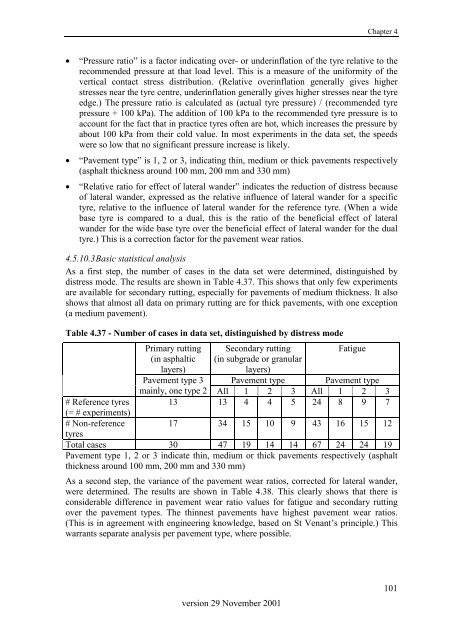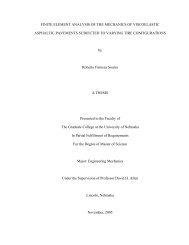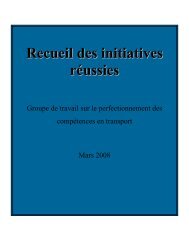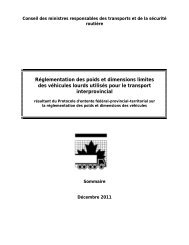Create successful ePaper yourself
Turn your PDF publications into a flip-book with our unique Google optimized e-Paper software.
Chapter 4• “Pressure ratio” is a factor indicating over- or underinflation of the tyre relative to therecommended pressure at that load level. This is a measure of the uniformity of thevertical contact stress distribution. (Relative overinflation generally gives higherstresses near the tyre centre, underinflation generally gives higher stresses near the tyreedge.) The pressure ratio is calculated as (actual tyre pressure) / (recommended tyrepressure + 100 kPa). The addition of 100 kPa to the recommended tyre pressure is toaccount for the fact that in practice tyres often are hot, which increases the pressure byabout 100 kPa from their cold value. In most experiments in the data set, the speedswere so low that no significant pressure increase is likely.• “Pavement type” is 1, 2 or 3, indicating thin, medium or thick pavements respectively(asphalt thickness around 100 mm, 200 mm and 330 mm)• “Relative ratio for effect of lateral wander” indicates the reduction of distress becauseof lateral wander, expressed as the relative influence of lateral wander for a specifictyre, relative to the influence of lateral wander for the reference tyre. (When a widebase tyre is compared to a dual, this is the ratio of the beneficial effect of lateralwander for the wide base tyre over the beneficial effect of lateral wander for the dualtyre.) This is a correction factor for the pavement wear ratios.4.5.10.3 Basic statistical analysisAs a first step, the number of cases in the data set were determined, distinguished bydistress mode. The results are shown in Table 4.37. This shows that only few experimentsare available for secondary rutting, especially for pavements of medium thickness. It alsoshows that almost all data on primary rutting are for thick pavements, with one exception(a medium pavement).Table 4.37 - Number of cases in data set, distinguished by distress modePrimary rutting(in asphalticlayers)Pavement type 3Secondary rutting(in subgrade or granularlayers)Pavement typeFatiguePavement typemainly, one type 2 All 1 2 3 All 1 2 313 13 4 4 5 24 8 9 7# Reference tyres(= # experiments)# Non-reference 17 34 15 10 9 43 16 15 12tyresTotal cases 30 47 19 14 14 67 24 24 19Pavement type 1, 2 or 3 indicate thin, medium or thick pavements respectively (asphaltthickness around 100 mm, 200 mm and 330 mm)As a second step, the variance of the pavement wear ratios, corrected for lateral wander,were determined. The results are shown in Table 4.38. This clearly shows that there isconsiderable difference in pavement wear ratio values for fatigue and secondary ruttingover the pavement types. The thinnest pavements have highest pavement wear ratios.(This is in agreement with engineering knowledge, based on St Venant’s principle.) Thiswarrants separate analysis per pavement type, where possible.version 29 November 2001101






